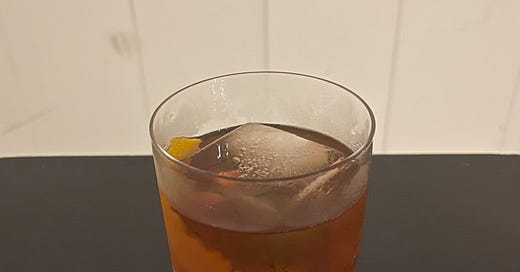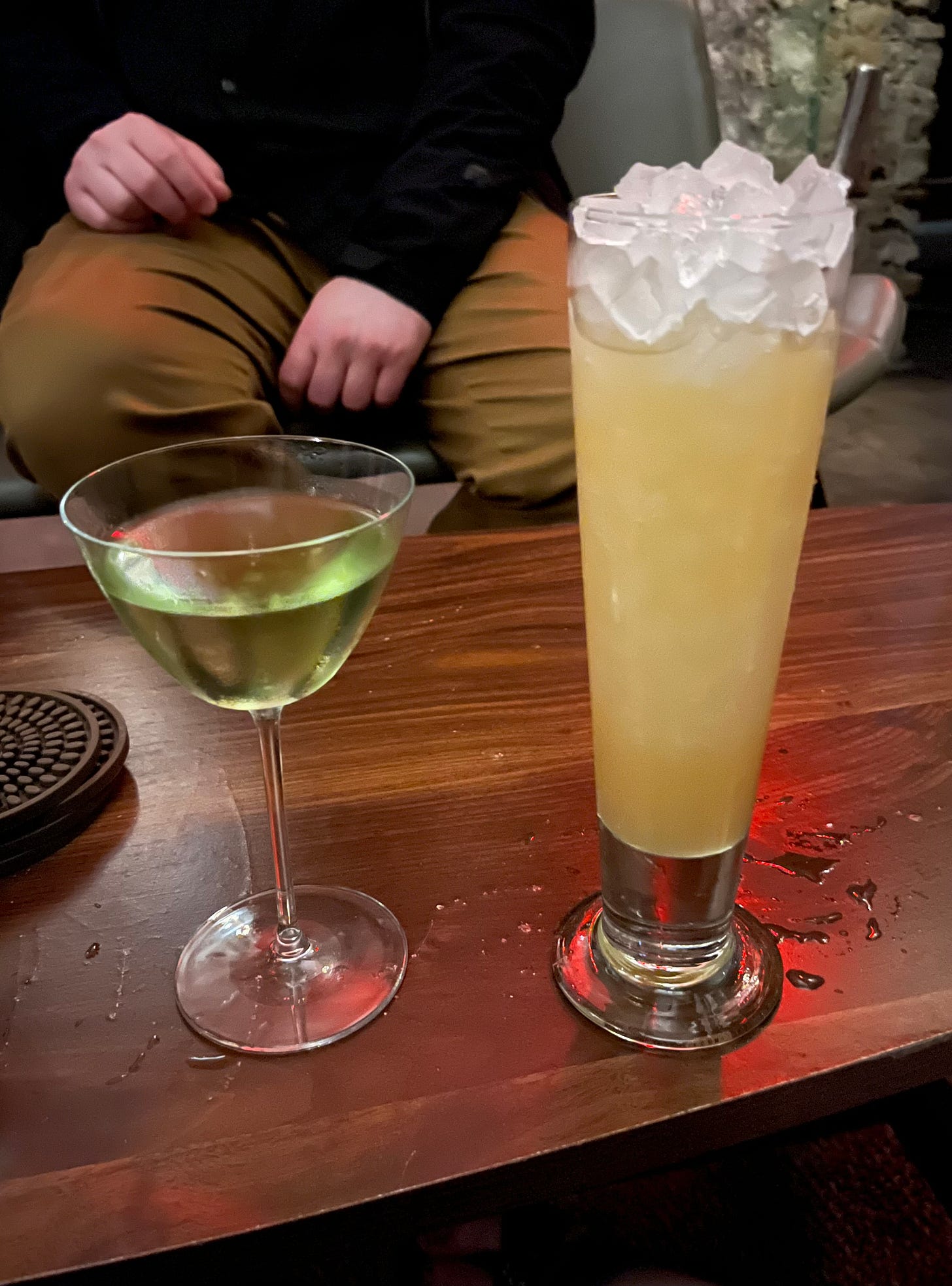Recipes for good cocktails can often frustrate me. I see a drink that piques my interest… and then I start to scroll. There’s an asterisk, sometimes multiple, leading me to a whole other recipe within the recipe for a syrup or infusion. Suddenly I need obscure fruits and herbs, citric acid, and a day for it all to steep — and oh, yeah, the recipe makes a quart of the stuff too, so now I have all this extra syrup. All for one drink!
Don’t get me wrong, I love to order a drink like this in a bar. Just recently, I was at Drastic Measures, a newly James Beard-nominated bar right in my hometown of Shawnee, Kansas, where I had a drink that expanded my mind: a Bijou riff called a Run the Jewels made with mint olive oil-washed tequila. It was a fantastically delicate bouquet of herbs, one of those drinks where a dozen flavors hit you at once but none is overpowering. But it’s also a drink I’d never make on my own, because what is mint olive oil anyway?
I don’t just want weird and surprising drinks in bars — I want them at home. Sure, sometimes a Margarita or an Old Fashioned sounds just perfect. But often, I’m mixing a drink to try something new, whether by doing something different with the bottles I already have or putting a spirit or liqueur I just bought into rotation. Occasionally I’ll experiment with a syrup or infusion if an idea seems too good to pass up, but I know I’ve only scratched the surface of the exciting drinks to be made with the ingredients I already have, and that one of those could just as well be a new favorite.
Kirk Estopinal and Maksym Pazuniak knew this too. In 2009, they were both working at the just-opened New Orleans bar Cure, and they were getting bored with the direction the cocktail world had been going. It was the middle of the cocktail renaissance, and bartenders all over were now using fresh juices and putting contemporary spins on classic or forgotten recipes. Kirk and Maks wanted something different. “We were looking to get inspired,” Kirk told VinePair a few years ago.
So they started breaking the rules, and looking for other bartenders who were too. That meant pouring bitters by the ounce instead of by the dash, stirring drinks when they were supposed to be shaken, and spotlighting obscure liqueurs and spirits that people hadn’t thought about for years, if ever. They compiled the recipes they’d made and collected into a book called Rogue Cocktails, which they self-published a few hundred copies of and started to spread among bartenders. Central to the book was a manifesto that Kirk and Maks had developed around these drinks. I’m not going to go through it point by point, but it pretty much amounts to that the drinks shouldn’t require specialty food ingredients or ample prep time, should be reproducible for bartenders, and should be both challenging and good-tasting.
Rogue Cocktails was short-lived thanks to a lawsuit from Rogue Spirits, but that led Kirk and Maks to publish a followup called Beta Cocktails in 2011, with some of the same recipes and some new ones. Both volumes are some of the most influential cocktail books of this century — as drinks authority Robert Simonson wrote in that VinePair story, they “managed to punch a good-sized hole in the fast-hardening orthodoxy of the craft cocktail movement.”
The first time I heard about Rogue and Beta Cocktails, it felt like the clouds had parted. (Shoutout to Leandro DiMonriva at the Educated Barfly for introducing me to Beta Cocktails and Jason O’Bryan at Robb Report for reminding me of it recently.) These were the sort of drinks I wanted to be making. In fact, I’d already made a few drinks from the book without even knowing, and I loved them. Now that I knew about this, I had to make as many of these drinks as possible.
So that’s what I’m going to do. Beta Cocktails is still in print (and still self-published!), so I’m going to mix my way through as much of1 the book as I can, Julie & Julia–style. The book is in alphabetical order, so I’m just planning to skip around — that way I can start with some of the most iconic drinks and work my way to the obscure stuff, plus I can make some of the more refreshing drinks in the summer and the more bracing ones in the winter. I’m going to make the drinks as faithfully to the original recipes as I can, but I’m not going to go out of my way to use a specific bourbon or to buy a whole bottle just for one rinse. (One of the “precepts” of Beta Cocktails is “Recipes are guidelines, not gospel.”) And I’m going to taste them and give my feedback. I can often tell what a drink is going to taste like from the recipe, but I have no idea what to expect from many of these, and some even slightly terrify me. I can’t wait.
I’m mainly doing this for myself — because as I laid out above, I want to make new and exciting drinks. But I’m publishing it because I hope it can be entertaining, or even helpful, for you. (Another precept: “Share recipes. It can inspire.”) I’m not trying to teach you how to make these drinks, and I’m definitely not saying everyone should make all of these drinks, but just maybe I can help you find one drink or spirit or technique that shakes up your drinking. Kirk and Maks write, “We hope this book sparks your imagination, compels you to question a technique or recipe you consider sacred, or otherwise leads you to think about cocktails in a different way.” That’s what I want to happen to me, but all the better if it happens to you too! And along the way, I’m also going to be writing about some of the odd ingredients that pop up and mixing some other drinks that relate to the ones in Beta Cocktails.
Logistically, I’m going to be publishing once a week, starting with the first recipe this Thursday. I’m starting an Instagram too, if you’d prefer to follow along with my drinks there. (I’m not an Instagram guy, and many of these drinks are not quite pretty, so don’t expect high quality.) If you’re not subscribed yet, why don’t you? And if you’re excited for the newsletter, please tell your friends or forward it to them!
A little about me: My first foray into cocktails was making Cosmos, and I still think that’s a perfect drink, vodka haters be damned. If I have to pick a favorite cocktail, it’s a Vieux Carré,2 which is like a Manhattan meets a Sazerac with an extra something you can’t put your finger on via Benedictine — a honeyed, nutty, herbal liqueur made by French monks. (The first one I had was described on the menu as “perfect.”) My favorite spirit is whiskey, but my favorite thing to mix with is amaro, or Italian bitter liqueurs, and I’ve been recently going through a rum phase too. But there aren’t many things out there that I actively dislike. I live in Chicago, where I’m absolutely spoiled for good cocktail bars. Oh, and when I’m not writing this newsletter, you can find me at Vulture, where I cover music.
If you’ve made it all the way to here, thanks for reading what will probably (hopefully) be the longest post I’ll ever write. I’ll be back soon with the wonderfully bizarre first drink. For now, here’s a song I’ve been enjoying — there’s even a line about Daiquiris:
So far, there are two drinks I’m pretty confident I’m not making. One is the Thrilla in Manila, which, even though it’s by the legend David Wondrich, doesn’t seem to fit the conceit of the book since it’ll require me to source palm sugar for a jaggery syrup. And one is the Notwist by Ciaran Wiese, which would require me to buy multiple expensive bottles that I wouldn’t use for any other recipe and don’t quite think are substitutable, cask-strength scotch and crema de mezcal.
The drink in the main photo is a Vieux Carré riff that swaps the cognac for El Dorado 12-Year rum, the Benedictine for allspice dram, and the Peychaud’s bitters for orange bitters. Thanks to
and his great cocktails newsletter for the idea.




